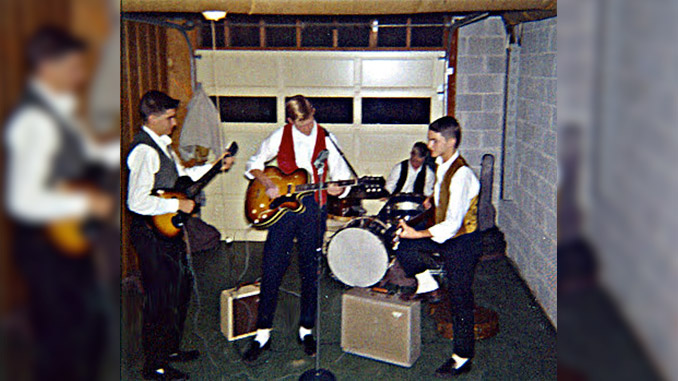
Welcome to Garage Rock School! In Garage Rock School we are by and by going to unfold the concept of garage rock by examining the most important testaments of the genre and tracking this music style’s evolution from the origins to the present.
All this will be performed with the motto knowhow & taste. But, relax. You are among friends and the management has a laid-back attitude towards its disciples. You may even keep your cap on during class (if it’s not an Emerson, Lake and Palmer-cap, that is). Moreover, this lesson offers some optional music intermissions (as clickable links) whenever you feel for a break.
Goal and scope for the first lesson
Well, the goal of this first lesson is that you will be (even) more confident about your idea of what garage rock is all about and also to be further self-assured in discriminating between garage and none-garage rock. We are going to fulfill this goal by at first (and pretty quick) go through the theoretic stuff and then move on to the practical side of garage rock. At the end there is a Task waiting for you.
Sharpening our senses by adopting a stricter ability to demarcate the quintessence of garage rock becomes handy in several situations, especially when particular topics of popular music are debated. In such discourse, it is important to have a firm understanding of the discussion subject, especially whenever (in this case) garage rock is at issue. Enhancement through exercising your notion of the garage rock concept therefore becomes useful.
Knowing more about garage rock is further motivated by the place-wise observed misconceptions and blurriness our subject matter sometimes suffers from – by what seems be due to a combination of ignorance and downright sloppiness. By accepting a far too liberal approach, music and bands not strictly garage rock may incorrectly be pigeonholed as such. An example of the (involuntary?) attempts to dilute the true essence of garage rock may be various overambitious “complete” catalogues of garage bands, like the one in Wikipedia, which suffers from that the start and stop years seems to comprise the only selection criteria.
Unfortunately, Internet record dealers without scruples also show same tendencies leading to false advertisement. Here, we stick to the old saying – to call a spade a spade and garage rock garage rock.
Initially, The School wants to give a warning in order to deflate potential incestuous hubris among its attendees: Please note that garage rock is not by any means superior to other types of music – it is just sounds somewhat different. And, as with any type of music, garage has its good and less good sides. Or Ups And Downs as part time garage rockers Paul Revere & the Raiders would have said.
Theory schmeory
Let us work through this at least semi-methodically. We will first get acquainted with the formal definition of the term “garage rock” and then turn to how it actually sounds. Wikipedia’s explanation is in this case a better reference point than its previously mentioned over-expanded list of garage bands:
“Garage rock (sometimes called ’60s punk or garage punk) is a raw and energetic style of rock and roll that flourished in the mid-1960s, most notably in the United States and Canada. The term derives from the perception that groups were often made up of young amateurs who rehearsed in the family garage, although many were professional.”
Please note the prescribed geographical and temporal limits given here. We stick to the term “garage rock” in this article instead of “’60s punk” or “garage punk” but regard them as synonyms as we find many names for those we love.
This theoretical point of departure for describing garage rock is necessary, but it is not enough, since our quest here is more honorable: to obtain a deeper understanding of the subject. During this lesson we will thus also want to know what garage rock really feels and sounds like as a mean to discriminate between garage rock and other types of kindred music. Enough said about this complementary couple of knowhow and taste.
By the way, a funny thing about the garage as a newfound rehearsal space in the ‘60s is that it gave the classical question to the parents “May I borrow the keys to the car?” a new twist, because this request just meant to clear the garage by reversing the car out on the drive-way.
Now it is high time to proceed to the particular object of study.
Study object
Our object of study selected for this lesson is Lenny Kaye’s seminal 2LP compilation Nuggets: Original Artyfacts from the First Psychedelic Era, 1965–1968, originally released by Elektra in 1972. Nuggets was instrumental in connecting the garage rock of the ‘60s with the ‘70s punk and new wave. In that respect, the wider spread re-issue on Sire (1976) probably had a greater impact than the original. This legacy has since then been transmitted to next generations of rock and rollers. Similarly, inspired by earlier historic blues and folk music compilations, Nuggets in turn paved the way for an array of other retro reflections of the same kind.
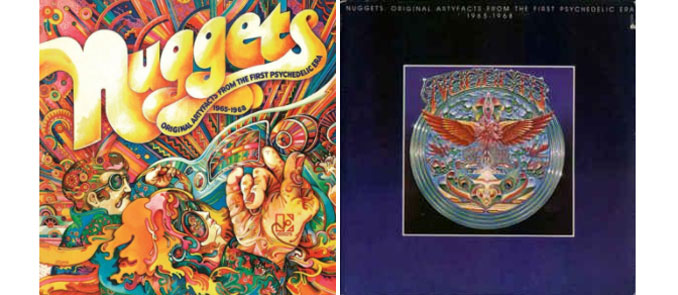
There is a short, way too short, mention of Nuggets in the book on the record company that released it, Becoming Elektra by Mick Houghton (Jawbone, 2010), on pages 271–272 were it is wrongly stated (no less than three times) that Nuggets is a compilation of singles by “garage bands”, thereby adding to the aforementioned dilution of our cherished definition. We will question this kind of description of history in the following. Elektra’s stronghold, The Stooges, was symptomatically also treated as a Cinderella in this book, by the way.
Construction of “garage rock” as a music identifier
A suitable approach to get a grip on our study object to begin with, is to treat its title literally and acknowledge it as a declaration of content. “Garage” is obviously not in the title. There are two reasons for this. 1. “Garage rock” had not yet become widely used in 1972. 2. Nuggets is (as we already anticipate) not a garage rock compilation.
To reflect on the first explanation, we address Greg Shaw’s editorial (Who Put The Bomp #12, 1975), in which he speculates on the possibility that phases of popular music are restricted to two–three year spans. The “punk rock” period (1964–66) is mentioned here as an example of one of these phases. Likewise, The Shadows of Knight is the only group on Nuggets that is recognized as a “garage-punk” band in Lenny Kaye’s liner notes – he thereby introduced a new tag that begun to stuck in the next few years.
It is therefore not a long shot to state that the label “garage rock” for this type of ‘60s music and “punk(-rock)” for the late ‘70s rough rock and roll, seem to have crystallized simultaneously and brought into wide operation when bands as The Ramones, The Sex Pistols and The Clash – to mention the most famous ones – started to make their mark in 1976–1977, prompting a collective term of these new band’s shared quality. We can be pretty sure about that since Lenny Kaye’s confirmed it in an e-mail conversion we had on the topic:
“Always glad to help in a discussion of garage … You’re right, the term didn’t come about until the later seventies, probably to distinguish it from the punk-rock that was currently coming to fruition….it certainly wasn’t in use in 1972 when the original Nuggets came out”
Rock and roll can thus be attributed as the common denominator for garage as well as punk rock. This view is corroborated by the fact that Lenny Kaye had in mind to change the title from Nuggets to Rockin’ and reelin’ USA in 1971 (Lenny Kaye: The Once and Future Nuggets; in Bomp – Saving the World One Record at a Time; pages 148–149). Elektra founder Jac Holzman fortunately warned against it, thereby preserving the listener’s guiding expectations in the right direction. The smart artyfacts/artifacts pun was also kept intact that way.
Dirty fingernails

Concerning the second explanation, that is to say stating that Nuggets not a garage-album, we have to turn to how the music itself sounds and also consider that the full title of the compilation tells us about the First Psychedelic Era (1965–1968). At first this definition seems to complicate our inspection of garage rock. However, after some contemplation, First Psychedelic Era might be clarifying instead, because things happened to traditional rock and roll (and to other styles as pop and folk music for that matter) when a dash of this mind expanding dimension was added parallel with a substantial portion of inspiration from bands that comprised the British Invasion. This time-period became particularly rich of experiments and innovations because of these influences.
The twelve bar concept in rock and roll was hereby complemented by other phrases of somewhat freer form but still, in the usual case, based on three chords progressions and simple rhythms. The garage rock sound was intrusive, often dominated by an obstinate fuzz-guitar adding noise to the general picture of distortion that the snarling song was embedded in and trying to drown out. Or, garage rock as the music equivalent to how low priced toilet paper relate to John Wayne: rough and tough and take shit from no one. And: do not forget to bring your maracas. Yeah, you get the picture.
The necessity of deconstruction
This refined and simplified description of garage rock must however be balanced by how the psychedelic era influenced popular music in the ‘60s by injecting some kind of eastern flavor to it. Exotic instrumentation, floating song structures, and solipsistic lyrics making the songs mimic and romanticize the sensations that contemporary drug intake induced is typical features of psychedelia.
From these two separate ideas of how respectively garage rock and psychedelia sounds like, we acknowledge that these pure forms often mix together in real life. When psychedelia is blended into garage rock the fuzz guitar gets challenged by keyboards of various kinds. Odd noises may appear. Furthermore, the cockiness becomes subdued in favor of a walk hand in hand with Alice in the Wonderland. Which one of the two kinds that dominates in a certain situation has to be judged from case to case, that is, from song to song.
And, as we shall see later on, when the sissy factor grows over a certain threshold – pop music also comes into the picture as another identification alternative next to garage rock. Nota bene: The Garage Rock School repeats for everybody’s safety that wimpy pop music is as such not necessarily inferior to other music styles – it just sounds less primitive. Similarly, blues, rhythm and blues and – to a certain extent folk music – also have their own respective distinct mark that mix into garage rock from time to time.
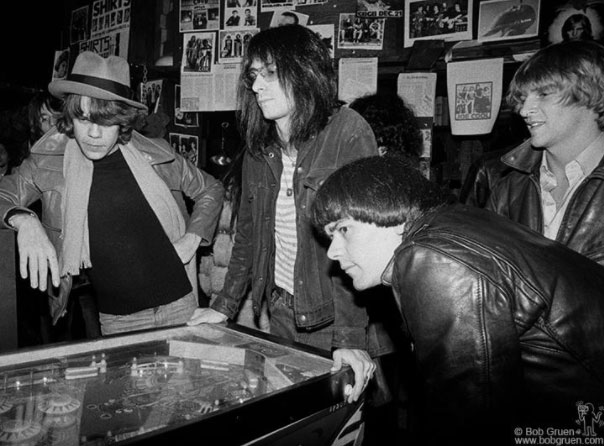
The listener must accordingly navigate in the reality where the abstract ideas about genres becomes impure and the borders between them get fuzzy. Individual songs are the best entities of judgement, because if focus is put on the artists performing them instead, these groups may own a diverse catalogue of songs; some in the garage rock genre some in another category. Since this repertoire also changes with time (if the career was long enough to offer variations) it gets even harder to label most of the bands under investigation as genuine garage rock bands. To paraphrase the saying “one swallow does not make a summer”: one garage rock song does not make a garage rock band.
A purist’s way of looking at it may translate to: A band is classified as a garage rock band only if a substantial part of a group’s output consists of garage rock. Not many combos that released more than two records will remain filed as garage rock bands with a strict rule like that. It strengthens our conviction that we better concentrate on the individual songs in the following, because it is not very fruitful to have a dead-end discussion on whether this or that band is a garage rock band or not. This energy can be redirected to the more relevant (and not so – but enough – tricky) discrimination between garage rock tunes and other types of songs under the secure auspices of Garage Rock School. Foremost for the fun of flexing the brain muscles when combining theory with practice, but also for sharpen and tuning the attention capabilities by performing these comparisons. Less for finding some kind of final “truth”. Let us agree to be open for disagreements.
Hey Ho – heterogeneity is the way to go
After this slight detour we are ready to sink deeper into our heterogeneous study object. We will just confirm the non-garage rock format of Nuggets once more by adding a comment straight from the master mind himself (which is affirmed in the Lenny Kaye interview in Shindig! # 58):
“….in fact, my album as you rightly surmise, is not as garage-rock as people think…it’s stylistically all over the place, especially since, when I assembled it, many of the tracks were not more than three to five years old, certainly not as much distance or perspective to make more than vague categorizations. In fact, to me, one of the strengths of my anthology is that it’s not specifically garage…it shows more the incredible sense of possibility that the sixties gifted the music’s growth, and avoids predictable definitions…. Makes it more listenable in many ways, if not as specifically parametered…“
Nuggets was compiled just a couple of years after the originals were released. The ease with how the licenses were obtained by Elektra indicates that the copyright owners did not think too much of the longevity of these songs at that time. By compiling Nuggets, Lenny Kaye most probably rescued a good portion of cross-sectional really good music from being relegated to oblivion. Such maneuver was important since the mainstream audience seems to be equipped with a goldfish’s memory span, which lead to choices without a historical frame work as reference. Most budget records at that time (as on labels as K-tel and, later on, Pickwick) did not have any raison d’être except a purely economic one which meant that these records were not carefully compiled.
Furthermore, the short time span between the original release and Nuggets, made classification harder to make at that time. It is easier to do such categorization in hindsight when the different varieties of dust of that time period has settled. As 45 years has passed by since Nuggets was first released, we got the distance in time needed for seeing things clearer. We are thus now ready for the Task.
The Task
What would a lesson be without a Task? As you may have suspected, you stand in front of a mission to weed out which of the 27 songs on the Nuggets original playlist that you consider good examples of garage rock – hopefully, you have got help from previous briefing.
Please, take your time to go through the material carefully before you compare it with the suggested “Nugget Map” below. Even though you know Nuggets by heart, remember that repetition is the mother of knowledge. Above all: Do not forget that beauty is in the ear of the beholder.
Nugget's track list
Nuggets’ track list and number of cover versions according to the site SecondHandSongs in June 2017. Numbers in bold font denotes the number of versions of these non-original songs. The bias towards garage rock in the amount of covers and US chart positions (right hand column) can explain why too many consider Nuggets a garage rock compilation.| Group | Song | Covers | US chart |
|---|---|---|---|
| The Electric Prunes | I Had Too Much To Dream (Last Night) | 018 | # 011 |
| The Standells | Dirty Water | 011 | # 011 |
| The Strangeloves | Night Time | 007 | # 030 |
| The Knickerbockers | Lies | 011 | # 020 |
| The Vagrants | Respect | 073 | - |
| Mouse | A Public Execution | 0 | # 121 |
| The Blues Project | No Time Like The Right Time | 0 | # 096 |
| The Shadows Of Knight | Oh Yeah | 005 | # 039 |
| The Seeds | Pushin' To Hard | 021 | # 036 |
| The Barbarians | Moulty | 0 | # 090 |
| The Remains | Don't Look Back | 003 | - |
| The Magicians | Invitation To Cry | 0 | - |
| The Castaways | Liar, Liar | 002 | # 012 |
| The Thirteenth Floor Elevators | You're Gonna Miss Me | 022 | # 055 |
| Count Five | Psychotic Reaction | 020 | # 005 |
| The Leaves | Hey Joe | 137 | # 031 |
| Michael And The Messengers | Just Like Romeo And Juliet | 014 | # 006 |
| The Cryan Shames | Sugar And Spice | 006 | # 049 |
| The Amboy Dukes | Baby Please Don't Go | 006 | # 106 |
| The Blues Magoos | Tobacco Road | 073 | - |
| Chocolate Watch Band | Let's Talk About Girls | 006 | - |
| The Mojo Men | Sit Down I Think I Love You | 006 | # 036 |
| The Third Rail | Run Run Run | 0 | # 053 |
| Sagittarius | My World Fell Down | 006 | # 070 |
| Nazz | Open My Eyes | 006 | # 112 |
| The Premiers | Farmer John | 027 | # 019 |
| The Magic Mushrooms | It's-A-Happening | 0 | # 093 |
Tentative mapping of Nugget songs
For some obscure reason, MC5’s rightfully speculated question whether “You going to be a part of the problem or part of the solution?” shows up in this context. We must ask if this inquiry from a distant past Detroit is relevant here? After some pondering, the School hope you disregard it, since the categorization problem is self-inflicted. Besides, it is hard to agree on an all-encompassing solution that fits everyone. Keep in mind the equivalent value of different musical genres, our preferred anti-militant attitude and that we are doing these listening gymnastics simply for pleasure.
But, instead of being content with the point of view that everybody’s opinion is alright when it comes to determine of what is and what is not garage rock (that would make this lesson fading out into a relativistic nothing), we infer some normative al dente by communicating an idea of how the content of Nuggets actually can be classified. Your own views may in that way be mirrored in and juxtaposed by how the 27 songs tentatively is arranged in a “Nugget Map” (see below) that displays the internal similarities and relations between the included songs versus involved musical styles (as conceived by the School). This way of presenting is quite different from common mapping used in music analysis that displays over-views of the inter-relation between different musical genres in which the details of the individual song contributions are neglected. Using the individual songs as markers instead, makes the “Nugget Map” show the whole diversity spectrum of the compilation.
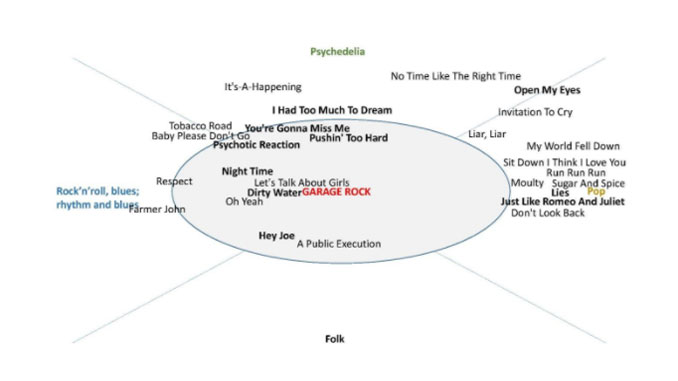
Anti-authoritarian closure
Of course, if you do not like this map, please go ahead and make one of your own. (The nearest neighbor genre is not self-evident, for one thing.) The School urges you to do such an effort instead of just being grumpy. The music discussion is elevated that way; by the contribution of each and every one of us keen garage rock listeners. Counter-acting present post-fact times, The School also wants to declare that “Knowing more is in fact hearing more!”. Keep your ears sharpened at all times.
The lesson ends with the bottom line that music listening should be fun (which does not rule out seriousness) and open-ended. Or as Lenny Kaye puts it:
“At any rate…enjoy, enjoy, and it’s a Nugget if You Dug It…..”
I just hope you have as much fun reading this article as I had putting it together.

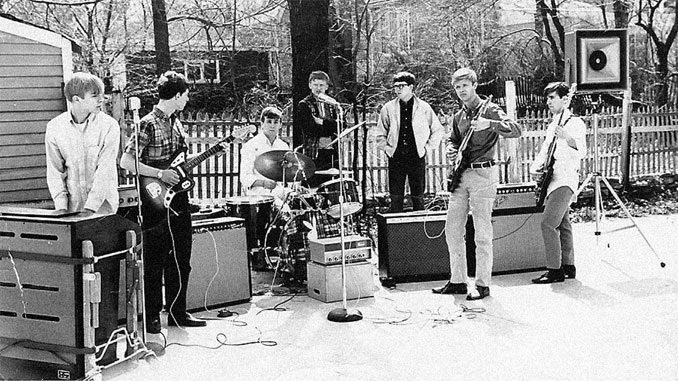
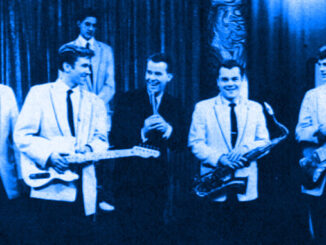
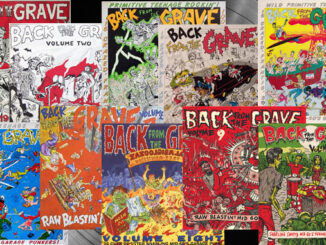
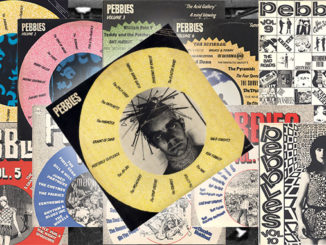
Thanks for the lessons !!! I’m really enjoying reading and reviewing them. From here I send my congratulations to the authors and my absolute gratitude.
From Basqueland, in the north of Spain.
Dear Jesus, Thanks for your kind words. Keep up the DJ-ing.
From Skåne, in the south of Sweden.
It’s strange that Lenny Kaye’s tastes in music were spot on, but his own music was bland and excruciatingly boring.
His first effort under the pseudonym Link Cromwell (1966) wasn’t that bad: https://youtu.be/ZDvmRb0Fqj4